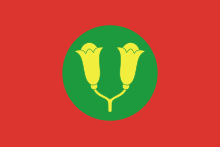Portal:Tanzania
 The Tanzania Portal
Tanzania, officially the United Republic of Tanzania, is a country in East Africa within the African Great Lakes region. It is bordered by Uganda to the northwest; Kenya to the northeast; the Indian Ocean to the east; Mozambique and Malawi to the south; Zambia to the southwest; and Rwanda, Burundi, and the Democratic Republic of the Congo to the west. Mount Kilimanjaro, Africa's highest mountain, is in northeastern Tanzania. According to the 2022 national census, Tanzania has a population of nearly 62 million, making it the most populous country located entirely south of the equator. Many important hominid fossils have been found in Tanzania, such as 6-million-year-old Pliocene hominid fossils. In the Stone and Bronze Age, prehistoric migrations into Tanzania included Southern Cushitic speakers who moved south from present-day Ethiopia; Eastern Cushitic people who moved into Tanzania from north of Lake Turkana about 2,000 and 4,000 years ago; and the Southern Nilotes, including the Datoog, who originated from the present-day South Sudan–Ethiopia border region between 2,900 and 2,400 years ago. These movements took place at about the same time as the settlement of the Mashariki Bantu from West Africa in the Lake Victoria and Lake Tanganyika areas. In the late 19th century, the mainland came under German rule as German East Africa, and this was followed by British rule after World War I when it was governed as Tanganyika, with the Zanzibar Archipelago remaining a separate colonial jurisdiction. Following their respective independence in 1961 and 1963, the two entities merged in 1964 to form the United Republic of Tanzania. Tanganyika joined the British Commonwealth and Tanzania remains a member of the Commonwealth as a unified republic. Tanzania is mountainous and densely forested in the north-east, where Mount Kilimanjaro, the highest mountain in Africa and the highest single free-standing mountain above sea level in the world, is located. Three of Africa's Great Lakes are partly within Tanzania. To the north and west lie Lake Victoria, Africa's largest lake, and Lake Tanganyika, the continent's deepest lake, known for its unique species of fish. To the south lies Lake Malawi. The eastern shore is hot and humid, with the Zanzibar Archipelago just offshore. The Menai Bay Conservation Area is Zanzibar's largest marine protected area. The Kalambo Falls, located on the Kalambo River at the Zambian border, is the second-highest uninterrupted waterfall in Africa. Tanzania is one of the most visited tourist destinations for safaris. Selected article -The sultans of Zanzibar (Arabic: سلاطين زنجبار) were the rulers of the Sultanate of Zanzibar, which was created on 19 October 1856 after the death of Said bin Sultan. He had ruled Oman and Zanzibar as the sultan of Oman since 1804. The sultans of Zanzibar were of a cadet branch of the Al Said Dynasty of Oman. In 1698, Zanzibar became part of the overseas holdings of Oman, falling under the control of the sultan of Oman. Omani and other Arab traders had already been prominent in trade with the island for hundreds of years. It was also visited by traders from Persia and India, who arrived with the seasonal musim (west wind). Months later they could return east with a change in the wind. (Full article...)General images -The following are images from various Tanzania-related articles on Wikipedia.
This month in Tanzanian history
Wildlife of Tanzania - Credit: Matthew Field
The Black Rhinoceros or Hook-lipped Rhinoceros (Diceros bicornis), is a species of rhinoceros, native to the eastern and central areas of Africa including Kenya, Tanzania, Cameroon, South Africa, Namibia, Zimbabwe, and Angola. Although the Rhino is referred to as black, it is actually more of a grey/brown/white color in appearance. The name of the species was chosen to distinguish it from the White Rhinoceros (Ceratotherium simum). Did you know ...
CategoriesWikiProjectsRecognised contentSelected panorama -Moshi is a Tanzanian town with a population of 144,739 (2002 census) in Kilimanjaro Region. The town is situated on the lower slopes of Mt Kilimanjaro, a volcanic mountain that is the highest mountain in Africa. Moshi is home to the Chagga and Maasai tribes and lies on the A 23 Arusha-Himo east-west road connecting Arusha and Mombasa, Kenya. Just to the east of Moshi is the intersection with the B 1 north-south road eventually connecting with Tanga and Dar es Salaam.
Uganda–Tanzania War -Articles here focus upon aspects of the Uganda–Tanzania War. These are all Good articles that meet a core set of high editorial standards.
During the Uganda–Tanzania War, the Battle of Bombo was fought in April 1979 at the town of Bombo, Uganda, between Tanzanian forces and Ugandan troops loyal to Idi Amin. After cutting the road between Kampala and Bombo, the Tanzanian 201st Brigade led by Imran Kombe was ordered to head north and seize Bombo. The town was mostly defended by retired Nubian officers of the Uganda Army. The Tanzanians attacked cautiously, and under heavy fire were able to proceed into the town and secure it. (Full article...) TopicsSelected picture - Credit: Winky
Dhow off the coast of Zanzibar at sunset. Dhows are traditional Arab sailing boats used primarily along the coasts of the Arabian Peninsula, India, and East Africa. ...Archive — Nominations
Related portalsThings you can doAssociated WikimediaThe following Wikimedia Foundation sister projects provide more on this subject:
Discover Wikipedia using portals | ||||









































































